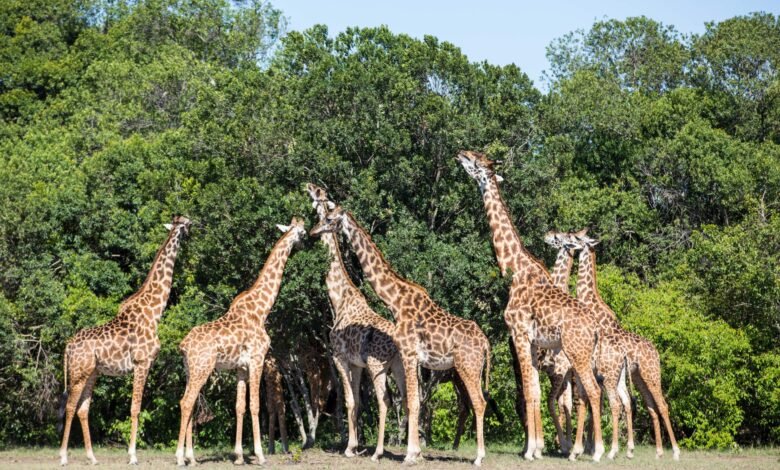
When you think of Kenya’s Masai Mara, the dramatic image of thousands of wildebeest surging across the Mara River likely springs to mind. The Great Migration, often called the ‘World Cup of Wildlife,’ is undoubtedly one of nature’s most breathtaking spectacles, drawing travelers from across the globe to witness this annual phenomenon. But the Masai Mara has much more to offer than the well-known migration. Beyond the thundering herds of wildebeest, the reserve teems with a diverse array of wildlife, each encounter providing a unique and unforgettable experience. Let’s explore some of the exceptional wildlife sightings that make the Masai Mara a must-visit destination year-round.
1. Big Cat Encounters: The Predators of the Mara
While the Great Migration brings a surge of prey species into the Mara, the reserve is also a haven for some of Africa’s most formidable predators. The Big Cats—lions, leopards, and cheetahs—are iconic residents of this wilderness. Observing these majestic creatures in their natural habitat is a thrilling experience.
- Lion Pride Dynamics: The Masai Mara is known for its strong lion populations, particularly the famed Marsh and Rekero prides. Watching a pride of lions, with cubs playing under the watchful eyes of lionesses, or observing the alpha male as he patrols his territory, offers an intimate glimpse into the social structures and behaviors of these apex predators.
- Leopard in the Trees: The elusive leopard, with its remarkable ability to camouflage and solitary nature, is one of the most challenging big cats to spot. The Mara’s riverine forests and rocky outcrops provide the perfect environment for these stealthy hunters. Spotting a leopard lounging on a tree branch or descending gracefully at dusk is a truly special sight.
- Cheetah on the Hunt: The open savannahs of the Mara are ideal hunting grounds for cheetahs. Known for their incredible speed, watching a cheetah sprint after a Thomson’s gazelle is a heart-pounding spectacle. The coalition of five male cheetahs, often referred to as the ‘Tano Bora,’ is a unique phenomenon that has fascinated wildlife enthusiasts and filmmakers alike.
2. The Great Elephant Herds
Elephants are another iconic species of the Masai Mara, with large family groups often seen traversing the plains or enjoying a bath in the muddy waters of the Mara River. These intelligent and emotional creatures provide an awe-inspiring experience, especially when you see a mother carefully guiding her calf or the playful antics of young elephants mock-charging or splashing in the water.
- Matriarchal Society: The elephant herds are led by a matriarch, the oldest and most experienced female. Observing the interactions within the herd—how they communicate, protect, and nurture their young—offers a deep appreciation for the complex social structure of these gentle giants.
3. The Rare and Endangered: Rhinos and Wild Dogs
While sightings are rare, the Masai Mara is home to some of Africa’s most endangered species, such as the black rhino and the African wild dog. Conservation efforts in the region have seen a gradual increase in their numbers, and encountering these animals in the wild is a humbling experience.
- Black Rhino: These shy, solitary animals prefer the thick bush for cover, making them difficult to spot. If you are fortunate enough to see one, it is a reminder of the critical need for continued conservation efforts to protect these magnificent creatures from the brink of extinction.
- African Wild Dogs: Also known as painted wolves due to their distinctive markings, wild dogs are one of the most efficient predators in Africa. Highly social animals, they operate in packs with a strict hierarchy. Observing a pack on the hunt or playing together is a rare and exhilarating experience.
4. Birdwatcher’s Paradise
The Masai Mara is a birdwatcher’s delight, boasting over 500 species of birds, including several endemic and migratory species. From the iconic African fish eagle’s call echoing over the Mara River to the vibrant colors of the lilac-breasted roller, birdlife in the Mara is as diverse as it is beautiful.
- Raptors Galore: The open savannahs are home to numerous raptors, including vultures, eagles, and hawks. Watching a martial eagle soar above or a group of vultures descending on a carcass is a stark reminder of the cycle of life and death in the wild.
- Ostrich Display: The world’s largest bird, the ostrich, is a common sight in the Mara. During mating season, the male’s elaborate courtship dance, with wings spread and feathers fluffed, is a fascinating display of avian behavior.
5. The Small but Mighty: Unusual Wildlife Encounters
While the big game often takes the spotlight, the Masai Mara is also home to a myriad of smaller creatures that are equally fascinating.
- Bat-Eared Foxes and Jackals: These small, nocturnal predators are often overlooked, but spotting them during an early morning or late afternoon game drive is a treat. Their large ears are not just for show; they help locate insects and small mammals underground.
- Servals and Caracals: These small, elusive cats are rarely seen, making any encounter special. The serval, with its long legs and spotted coat, is an excellent hunter of rodents and birds, while the caracal, with its tufted ears, is known for its incredible leaping ability to catch birds in flight.
6. Cultural Encounters: The Maasai People
No visit to the Masai Mara is complete without experiencing the rich culture of the Maasai people. The Maasai, with their distinctive red shukas and intricate beadwork, have lived in harmony with the land and its wildlife for centuries. Visiting a Maasai village provides insight into their traditional way of life, and a chance to learn about their customs, beliefs, and the challenges they face in modern times.
- Warrior Dance and Jumping: The Maasai are renowned for their warrior dance and the ‘adumu’ or jumping dance, where young men compete to jump the highest as a show of strength and agility. Participating in or witnessing this cultural display is an unforgettable experience.
Conclusion
The Masai Mara is much more than the spectacle of the Great Migration. Its diverse landscapes, from open savannahs to acacia-dotted plains and riverine forests, support a staggering variety of wildlife. Each season brings new opportunities to witness the intricate and interwoven tapestry of life here. Whether you are watching a pride of lions on a hunt, a family of elephants at a waterhole, or the vibrant display of birdlife, the Masai Mara offers endless opportunities for unique and intimate wildlife encounters. For those willing to look beyond the wildebeest herds, the Mara reveals its true magic—a place where every moment is an invitation to connect with nature in its most raw and beautiful form.



